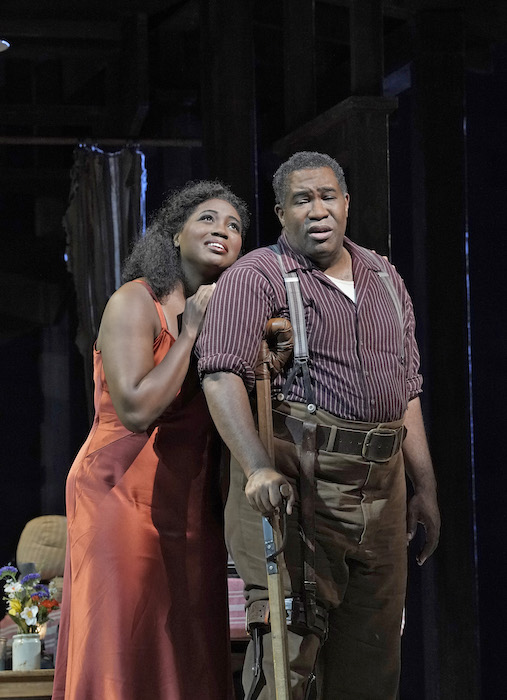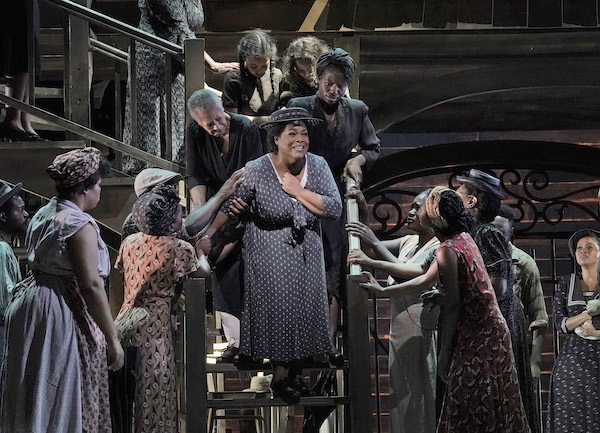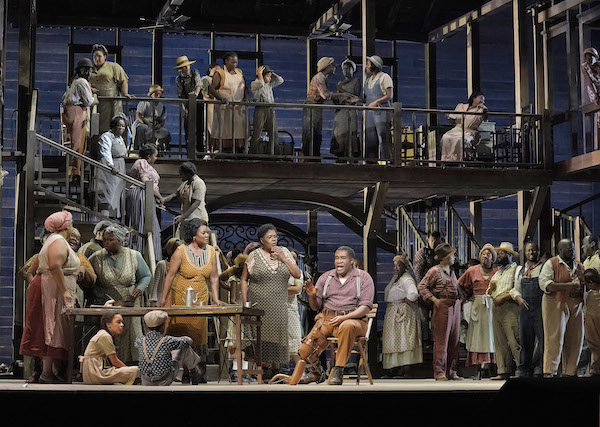Met opens season with a heartening and memorable “Porgy and Bess”

Since its debut, Porgy and Bess has been consistently hectored by two questions: is it an opera and is it some combination of condescension and racial exploitation (lately termed cultural appropriation)?
The debut of a new production of Porgy and Bess, which opened the season at the Metropolitan Opera Monday night could leave no objective listener with any doubt as to the answer to the first question. And based on the excited responses from the audience during the performance, and the rapturous applause and shouts at the end—from the kind of patron mix one sees in everyday life in New York City but rarely in a classical music venue—the work has gone quite a ways toward settling the latter in a heartening and beneficent way.
Monday’s opening night performance had more dynamic energy, more direct human communication, and possibly more fine singing than one has seen at the Met over the last several seasons. The house has the luxury of casting the very best singers, and for Porgy and Bess that means the very best African-American opera performers, who are indeed among the finest on the scene. That means bass-baritone Eric Owens and soprano Angel Blue in the leads, with the supporting characters sung by bass-baritone Ryan Speedo Green, sopranos Latonia Moore and Golda Schultz, and mezzo-soprano Denyce Graves. And that doesn’t even begin to list the stellar house debuts.
Credit the lead performers, but a substantial amount of the force of the performance came from the African-American chorus assembled by the Met for this production—not just their vibrant singing but the direction from producer James Robinson and the choreography for them and a small set of dancers, created by Camille A. Brown (both making their Met debuts). Catfish Row was full of life, from people going about their work and chores to gripping and visceral expression of charismatic Christianity at the moments of greatest sorrow and crisis. The village was not full of characters–it was full of genuine people.
Doubts about Porgy and Bess’s musical qualities have been a legacy of American high culture in the early 20th century, which looked from the east coast to Europe for directions on what was good or bad. Opera in English was seen as suspect exactly because it was in English, much less George Gershwin’s vernacular music and librettist Dubose Heyward’s Gullah dialect. Opera is a form, not a style, and if Verdi’s use of vernacular music and language in his work was good enough for Italian audiences (and American ones) than jazz, blues, gospel, and the sounds of how people talk is good enough for everyone.
Dialect is exactly where Porgy and Bess has made listeners from Virgil Thomson to Harold Cruse uncomfortable, and the language and setting are honestly difficult and emotionally fraught for some, who hear teh libretto by Heyward (a white Southern writer) as full of stereotypes, though still with real sympathy for the characters—that opera in general stereotypes characters is no help.
But one felt that the inevitable social and political questions were put aside Monday, and sensed no doubts from the audience, by the quality of the performances.
The opera has the advantage of capturing the listener by opening with one of the greatest American songs, “Summertime,” sung with crystalline grace and beauty by Schultz as Clara. After that bit of willful seduction, one was immersed in the feeling of reality coming from, of all places, the operatic stage. There was a naturalness to the production, but much more the at-ease solidity of Green as the fisherman Jake, Clara’s husband, bass-baritone Alfred Walker’s confident masculinity as Crown, the way Graves, as Maria, used a mix of singing and intoned speech to create an absolute command of Catfish Row and the stage itself.
Owens and Blue delivered affecting performances. The bass-baritone shook off some early leather in his voice and sang with expressive warmth. Surrounded by so many powerful voices, he sounded gentle and carved out space for himself with his phrasing, which was musical in the extreme. On paper, the naïve faith that Porgy has in Bess, and the simplicity and seriousness of his determination to follow her to New York and find her there, seem nearly ridiculous, but Owens made them more than believable, he made them logical.
Like Owens, Blue used her voice to give life to a complex and difficult character. Everything about her singing was transformational, from her blunt means in her first appearance, with Crown, to the way she softened and lengthened her legato as she took to Porgy—the duet “Bess, You Is My Woman Now” was gorgeous, and her compulsion to return to Crown after the picnic was just as real. Near the end, holding the now-dead Clara’s baby, her “Summertime” took on a whole new meaning through its utter clarity.
Tenor Frederick Ballentine debuted at the house at Sportin’ Life, and was excellent. His singing was clear and youthful, and he slid and danced around the stage with the attractive charisma of the most compelling and realistic villains.

As Serena, Moore nearly stole the show. The spiritual “Gone, Gone, Gone” that the chorus sings over Robbins’ (tenor Chauncey Packer, making his own Met debut and doubling as Crab Man) is one of the most moving episodes in the opera. But Moore’s singing of “My Man’s Gone Now,” was stunning—sonically beautiful while full of bitter, wrenching sorrow. When she sang “Oh, Doctor Jesus” to cure Bess’ fever, the entire house held its collective breath. When her character collapsed in grief on stage, Moore received an extended, roaring ovation from the audience. Even conductor David Robinson applauded from the pit.
That was not even all of the great singing. Every role was terrific, and one of the very finest musical passages was soprano Leah Hawkins, singing the Strawberry Woman’s song. Barely a minute and a half of music, she stopped the show.
The sets, designed by Michael Yeargan, and Donald Holder’s lighting design worked together with subtle and intelligent means. Catfish Row was built as an exposed superstructure, spartan rooms lofted above a courtyard and the flooding ocean. Holder’s shades and the turning stage created a flow of changing times of day, weather, and seasons. There was no noticing the mechanism by which any of this worked, one felt the effect.
At the beginning and in the end, there is Gershwin’s wonderful music. While there could have been a touch more jazz to some of the syncopated rhythms, Robertson’s conducting and the MET Orchestra’s playing were as superb as the singing. Dazzling instrumental colors came out of the pit, and the musicians responded directly to the singers.
On top of that, there is the unique experience of having popular and jazz recordings of things like “Summertime” and “It Ain’t Necessarily So” filed away in one’s head, then experiencing them in their original form on the stage.
That is, unfortunately, a unique opportunity in this country (Monday night was only the Met’s 55th performance of Porgy and Bess) but one that resonated with a pleasure one won’t find with Verdi or Puccini or Mozart or Wagner.
Porgy and Bess continues through February 1. Elizabeth Llewellyn sings Bess October 13, and Kevin Short sings Porgy January 8 and 11. metopera.org; 212-362-2000
